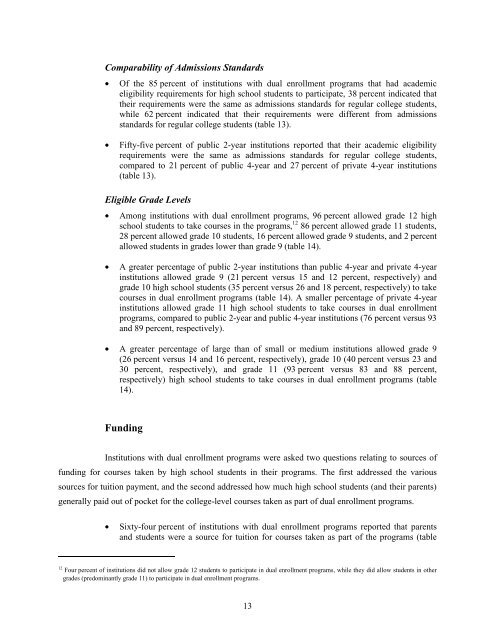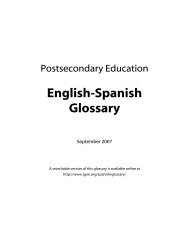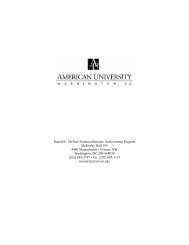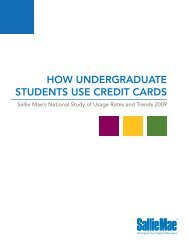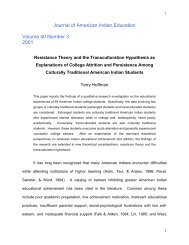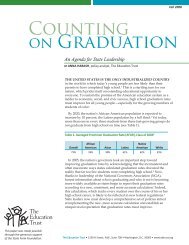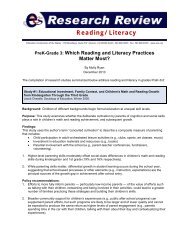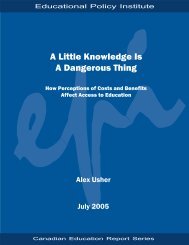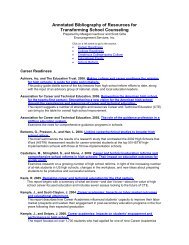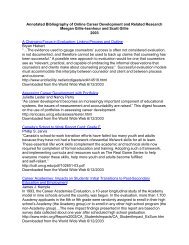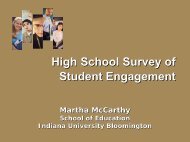Dual Enrollment of High School Students at Postsecondary Institutions
Dual Enrollment of High School Students at Postsecondary Institutions
Dual Enrollment of High School Students at Postsecondary Institutions
Create successful ePaper yourself
Turn your PDF publications into a flip-book with our unique Google optimized e-Paper software.
Comparability <strong>of</strong> Admissions Standards<br />
• Of the 85 percent <strong>of</strong> institutions with dual enrollment programs th<strong>at</strong> had academic<br />
eligibility requirements for high school students to particip<strong>at</strong>e, 38 percent indic<strong>at</strong>ed th<strong>at</strong><br />
their requirements were the same as admissions standards for regular college students,<br />
while 62 percent indic<strong>at</strong>ed th<strong>at</strong> their requirements were different from admissions<br />
standards for regular college students (table 13).<br />
• Fifty-five percent <strong>of</strong> public 2-year institutions reported th<strong>at</strong> their academic eligibility<br />
requirements were the same as admissions standards for regular college students,<br />
compared to 21 percent <strong>of</strong> public 4-year and 27 percent <strong>of</strong> priv<strong>at</strong>e 4-year institutions<br />
(table 13).<br />
Eligible Grade Levels<br />
• Among institutions with dual enrollment programs, 96 percent allowed grade 12 high<br />
school students to take courses in the programs, 12 86 percent allowed grade 11 students,<br />
28 percent allowed grade 10 students, 16 percent allowed grade 9 students, and 2 percent<br />
allowed students in grades lower than grade 9 (table 14).<br />
• A gre<strong>at</strong>er percentage <strong>of</strong> public 2-year institutions than public 4-year and priv<strong>at</strong>e 4-year<br />
institutions allowed grade 9 (21 percent versus 15 and 12 percent, respectively) and<br />
grade 10 high school students (35 percent versus 26 and 18 percent, respectively) to take<br />
courses in dual enrollment programs (table 14). A smaller percentage <strong>of</strong> priv<strong>at</strong>e 4-year<br />
institutions allowed grade 11 high school students to take courses in dual enrollment<br />
programs, compared to public 2-year and public 4-year institutions (76 percent versus 93<br />
and 89 percent, respectively).<br />
• A gre<strong>at</strong>er percentage <strong>of</strong> large than <strong>of</strong> small or medium institutions allowed grade 9<br />
(26 percent versus 14 and 16 percent, respectively), grade 10 (40 percent versus 23 and<br />
30 percent, respectively), and grade 11 (93 percent versus 83 and 88 percent,<br />
respectively) high school students to take courses in dual enrollment programs (table<br />
14).<br />
Funding<br />
<strong>Institutions</strong> with dual enrollment programs were asked two questions rel<strong>at</strong>ing to sources <strong>of</strong><br />
funding for courses taken by high school students in their programs. The first addressed the various<br />
sources for tuition payment, and the second addressed how much high school students (and their parents)<br />
generally paid out <strong>of</strong> pocket for the college-level courses taken as part <strong>of</strong> dual enrollment programs.<br />
• Sixty-four percent <strong>of</strong> institutions with dual enrollment programs reported th<strong>at</strong> parents<br />
and students were a source for tuition for courses taken as part <strong>of</strong> the programs (table<br />
12 Four percent <strong>of</strong> institutions did not allow grade 12 students to particip<strong>at</strong>e in dual enrollment programs, while they did allow students in other<br />
grades (predominantly grade 11) to particip<strong>at</strong>e in dual enrollment programs.<br />
13


